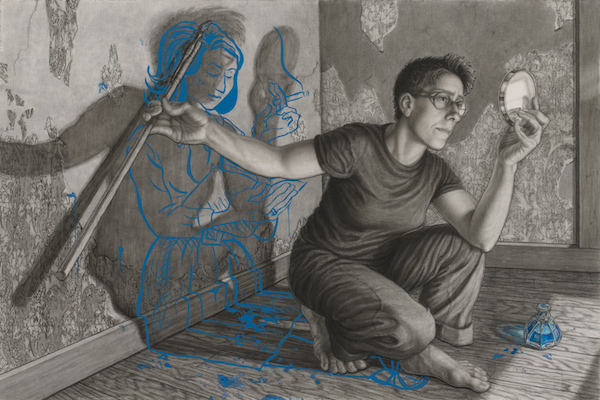By Athena Naylor
This article was first published in The DC Line.
The contrasting pursuits of DC artist and American University professor Ian Jehle are both on full view in a new exhibit at the university’s Alper gallery space, with Jehle’s well-known, large-scale figurative drawings of prominent members of the DC arts community displayed alongside his abstract, geometric work that’s rooted in his training as an engineer.
Jehle was initially hesitant about placing these two aspects of his artistic practice side by side, according to curator Laura Roulet’s introductory wall text for Ian Jehle: Dynamical Systems at the American University Museum in the Katzen Arts Center. Visitors will be thankful his skepticism was short-lived. Sharing a space, Jehle’s mathematically inspired work and his large-scale portraits create an engaging and imaginative gallery experience.
The exhibit’s title refers to a mathematical concept. In scientific models, “dynamical systems” convey the evolution of a certain state over time, such as calculating the mechanics of a moving point through space (the swinging of a pendulum, for example). In broader terms, dynamical systems illustrate the relationships between variables in space and time.
This nod to the mathematical influences in Jehle’s abstract work also points to the show’s larger theme of interrelation. In the introductory text for the show, Jehle explains that his aim in combining his portraiture and abstract work was “to focus [the] geometric work on distorting, stretching and augmenting the Alper Gallery space and then placing the portraits within that augmented space and seeing how they react.”
Jehle’s abstract work complements his portraiture. The exhibit’s first geometric installation — “Tile/Trial: Anti-Tiling Permutations in the Form of a Game” — represents the result of a game played by American University students in adherence to Jehle’s instructions. Competing teams equipped with red and blue tape laid down patterns in order to block the opposing team’s tiling efforts, resulting in tessellations of red and blue tape that cover the glass doors, floors and walls of the Alper Gallery and guide visitors toward the first portrait of the exhibit, “The Gallerist.” Further inside, intersecting red, blue and green bungee cords arc across the walls and ceiling to create a visual frame for the largest and most striking drawing in the show, “The Collectors (Richard Gould and Lena Skanby).”
The interrelations between other abstract pieces and Jehle’s portraits are not as straightforward. Separated from the rest of the exhibit via a partition, the tape mural “The Transit of a Hilbert Space onto a Hilbert Space is itself a Hilbert Space” depicts a maze-like area folded into itself, a two-dimensional representation of a convoluted three-dimensional construction. Across the way, two portraits of local art collectors — “Philip Barlow” and “Lisa Gilotty” — seem to look out past “Hilbert Space” at the viewer.
Rather than seeking to draw conclusions from the physical orientation of these three pieces, it seems more appropriate to consider the relationships among them conceptually. “Hilbert Space” encapsulates Jehle’s aim to augment space by distorting our understanding of two dimensions and three dimensions on a theoretical level. “Philip Barlow” and “Lisa Gilotty” similarly provoke questions of space, though they do so in terms of interpersonal distance.
Interpersonal distance arguably affects all portraiture, no matter the style or subject, since the genre’s conceit is to create a two-dimensional stand-in for a three-dimensional person. However, Jehle’s portraiture particularly emphasizes the push and pull of familiarity and detachment. “Philip Barlow” and “Lisa Gilotty” draw the viewer to the nearly life-size subjects, only to find both portraits so faintly rendered in colored pencil that they seem to glow with immateriality, appearing translucent and insubstantial.
In other drawings — “Iona Rozeal Brown” and “Henry Thaggert,” for example — Jehle opts to leave his subjects’ faces unfinished and floating in a void, relying on viewers to complete the portrait in their mind. In “The Collectors (Richard Gould and Lena Skanby),” Jehle challenges notions of interpersonal distance by depicting an intimate moment on a monumental scale. The beautifully rendered 72-inch-by-151-inch drawing depicts partners Richard Gould and Lena Skanby in the midst of an open-mouthed kiss, their tongues colliding in the center of the composition.
Though Jehle’s drawings represent people he knows “to varying degrees,” he inserts interpersonal distance between himself and his subjects through his drafting process. Jehle does not ask his subjects to model for him. Instead, the artist creates composite images of friends and acquaintances by relying on photos of his subjects, along with other models whose body type is similar to that of his chosen subject.
Jack Rasmussen, director and curator of the American University Museum at the Katzen Arts Center, describes Jehle’s portraits as “right-brain feats” and his geometric installations as products of the artist’s left brain. This description, while acknowledging the differences between Jehle’s drawings and abstract artworks, also insists on their similarities, as the left brain and right brain necessarily connect to create a cohesive whole.
So it is with Jehle’s geometric and figurative work in Dynamical Systems. Both the mathematically inspired installations and portraits are well-executed and enjoyable on their own, but their union encourages comparison and conjecture. The harmony of Jehle’s two artistic approaches is difficult to articulate, but to leave the gallery with concrete conclusions seems antithetical to the exhibit’s intentions. As curator Laura Roulet writes of the show, “The conditions are set for wonder.”
Ian Jehle: Dynamical Systems, presented by the Alper Initiative for Washington Art, opened Nov. 10 and closes Dec. 16. Jehle will join curator Laura Roulet to discuss the site-specific installation on Thursday, Nov. 29, at 5:30 p.m.; admission is free, but reservations are required. The Alper gallery space is part of the American University Museum at the Katzen Arts Center, which is across from the university’s main entrance at 4400 Massachusetts Ave. NW.





No Comments